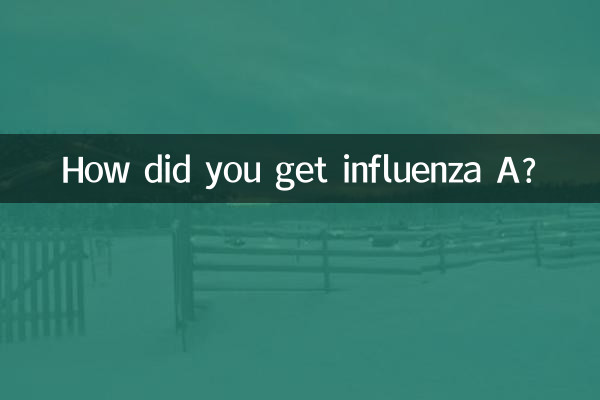How did you get influenza A?
Recently, influenza A (referred to as influenza A) has once again become a hot topic of public concern. As seasons change and crowd movement increases, the risk of influenza A transmission also increases. This article will combine the hot topics and hot content on the Internet in the past 10 days to provide you with a detailed analysis of structured data such as the transmission routes, susceptible groups, and preventive measures of influenza A, to help everyone better understand and respond to influenza A.
1. The transmission route of influenza A

Influenza A mainly infects the human body through droplet transmission and contact transmission. The following are the main ways in which influenza A is spread:
| Transmission route | Specific methods |
|---|---|
| droplet spread | Droplets produced when an infected person coughs, sneezes, or talks and are inhaled by others |
| contact spread | Touching a virus-contaminated surface before touching your mouth, nose or eyes |
| airborne | In a confined space, the virus may spread by being suspended in the air for long periods of time |
2. Susceptible groups of influenza A
Although anyone can become infected with influenza A, certain groups of people are at a higher risk. The following is a classification of susceptible groups:
| Susceptible groups | Risk reasons |
|---|---|
| child | The immune system is not fully developed and the resistance is weak |
| elderly | Decreased immunity, often accompanied by chronic diseases |
| pregnant woman | Immune system changes during pregnancy, making you more susceptible to viral infections |
| Chronic disease patients | Patients with heart disease, diabetes, etc. have lower resistance |
3. Preventive measures against influenza A
The key to preventing influenza A is to cut off transmission routes and enhance one's own immunity. The following are effective preventive measures:
| Precautions | Specific methods |
|---|---|
| wash hands frequently | Use soap or hand sanitizer and wash for at least 20 seconds |
| Wear a mask | Wear a medical mask in crowded or confined spaces |
| avoid contact | Reduce close contact with people suspected of being infected |
| Get vaccinated | Get an annual flu shot to reduce your risk of infection |
4. Symptoms and treatment of influenza A
Symptoms of influenza A are similar to those of the common cold, but are usually more severe. The following are common symptoms of influenza:
| symptom | describe |
|---|---|
| fever | Body temperature can reach above 38℃ and last for 3-4 days |
| cough | Dry cough or phlegm |
| Weakness | General weakness, muscle aches |
| Headache | Persistent headache, possibly with photophobia |
If the above symptoms occur, it is recommended to seek medical treatment in time. Your doctor may prescribe antiviral drugs (such as oseltamivir) for treatment. At the same time, patients should rest more, drink more water, and avoid close contact with others to prevent the spread of the virus.
5. Popular trends of influenza A
According to the hot data of the entire network in the past 10 days, the popular trends of influenza A are as follows:
| area | Popularity |
|---|---|
| northern region | Case numbers are on the rise, especially in schools and nursing homes |
| southern region | The number of cases is relatively stable, but we need to be wary of seasonal rebounds |
| big city | Densely populated, high risk of transmission, need to strengthen prevention and control |
To sum up, the spread of influenza A is closely related to season, crowd density and personal protection measures. By understanding the transmission routes, susceptible groups and preventive measures of influenza A, we can better protect the health of ourselves and our families. I hope everyone can pay attention to the prevention and control of influenza A, respond scientifically, and reduce the risk of infection.

check the details

check the details